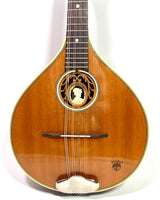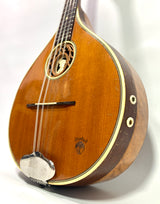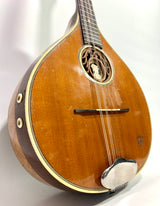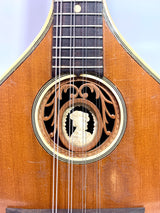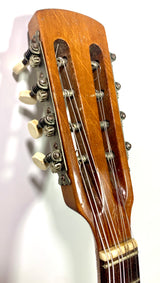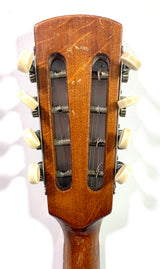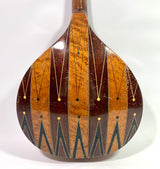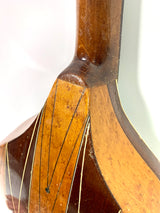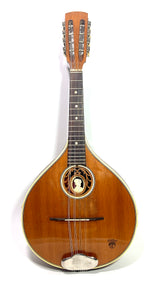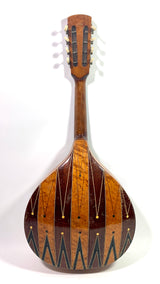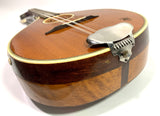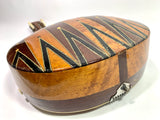Ernst Reinhold Schmidt
Mandolin Workshop Ernst Reinhold Schmidt (ERS) 1920/1930's
€0
Since Georg Victor Emanuel Wettengel, the production of stringed musical instruments and particularly the mandolin in the Vogtland region of Germany has developed since the end of the 19th century.
And if we had to define a capital of this region, it is quite natural that we would point the finger: Markneukirchen.
This mandolin was certainly made in Markneukirchen, as indicated by its construction with a Portuguese-style body.
This base is also made up of 7 parts and the sides of two parts, which was common on so-called more high-end mandolins from this region of Germany.
We can still observe it in Kurt Gropp's catalogs from the early 1950s where mandolins with even more complex backgrounds than this one are presented.

From Kurt Gropp's catalog from the early 1950s.
(Source: Markneukirchen Museum)
At the beginning of the 20th century, mandolin production in Markneukirchen became even more active.
Since Italian influence a few decades earlier, the demand for mandolins has exploded.
Although the majority of mandolins first produced were models copied from Italian mandolins, little by little, we see the emergence of flat-bottomed mandoline models. At first, these were of poor quality although some more expensive and good quality models existed.
Naturally, these mandolins differed in sound from Italian mandolins, but they suited the repertoire of folk songs played in many mandolin clubs of the time in Germany.
There were two majority table forms. Namely, lute shapes ("Spitze Form") and Portuguese shapes (drop shape).

Portuguese guitar by Manuel Agostinho from 1926.
(Source: Music Museum of the Philharmonie de Paris)

Lute-shaped mandolin sometimes called "German form" manufactured by AE Dreier at the beginning of the 20th century.
(Source: British Museum)
Both models were available in the simple flat-back version. And for an extra fee, they were also available with rounded backs consisting of five or seven ribs, as is the case with our mandolin here.
So, this model was like an intermediate model between the flat mandolin and the Neapolitan bowlback mandolin.
It should be noted that the most popular model was the Portuguese model like this one.
In addition, we noted very quickly after the development of the Calace twin-holes, the takeover by German manufacturers of this innovation.
Indeed, we can see twin-holes in the Calace style on a very large number of German mandolins from the 1910s/1920s.
These will be placed between the soundhole and the bridge or on the sides, sometimes even on each side of the sides, as is the case on this mandolin.

Mandolin by Raffaele Calace, featuring twin-holes.
(Source : Music Museum of the Philharmonie de Paris)
In addition to these particularities and its specific construction, the mandolin has an iron mark at the bottom right of the soundboard (when looking at the table from the front).
This brand is that of the workshop of Ernst Reinhold Schmidt, famous luthier from Markneukirchen.
Ernst Reinhold Schmidt (1857-1928) was born in Markneukirchen, Germany, where he apprenticed as a violin maker with J. Kretzschman. He then worked for the Bausch and Hammig workshop in Leipzig and for the famous manufacturer August Riechers in Berlin. ER Schmidt then returned to Markneukirchen and opened his own company in 1884: ER Schmidt & Company. With the help of his brother, the ER Schmidt shop and became one of the most successful workshops in Markneukirchen in the early 1900s and achieved national and international success.
Subsequently, his sons continued to work in this field by opening a company in the United States, in Ohio, which continued to import instruments from Germany.
It would therefore be very likely that this mandolin was a specific order from the workshop of Ernst Reinhold Schmidt for one of his clients. Which would justify the rose window decorated in its center with wooden arabesques and a man's profile in the cameo style which would be the portrait of Wagner.

Technical characteristics :
- Top: Spruce
- Bottom : Bird's eye maple / Mahogany / Black stained mahogany
- Sides: Bird's eye maple / Mahogany
- Neck: Maple
- Fingerboard: Rosewood
- Width at nut: 28.5mm
- Radius: Flat
- Frets: 17 frets (+ 1 zero fret)
- Scale: 330mm
- Profile: Rounded V / Between Roman and Neapolitan
- Country of manufacture: Germany, Markneukirchen
- Year: 1920/1930's
- Finish: Natural
- Decorations: background decorated with rosewood fillets and white plastic / Table fillets in white-black plastic and rosewood / Interior of the rosette decorated with arabesque motifs and a right profile portrait in cameo style
Rich in history, this mandolin sounds great. It is effectively placed between the flat mandolin and the Neapolitan mandolin with a bowlback base.
Delivered without cover.

